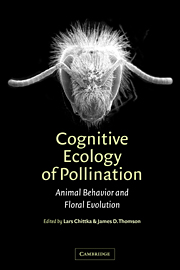Book contents
- Frontmatter
- Contents
- List of contributors
- Preface
- 1 The effect of variation among floral traits on the flower constancy of pollinators
- 2 Behavioral and neural mechanisms of learning and memory as determinants of flower constancy
- 3 Subjective evaluation and choice behavior by nectar-and pollen-collecting bees
- 4 Honeybee vision and floral displays:from detection to close-up recognition
- 5 Floral scent, olfaction, and scent-driven foraging behavior
- 6 Adaptation, constraint, and chance in the evolution of flower color and pollinator color vision
- 7 Foraging and spatial learning in hummingbirds
- 8 Bats as pollinators: foraging energetics and floral adaptations
- 9 Vision and learning in some neglected pollinators: beetles, flies, moths, and butterflies
- 10 Pollinator individuality: when does it matter?
- 11 Effects of predation risk on pollinators and plants
- 12 Pollinator preference, frequency dependence, and floral evolution
- 13 Pollinator-mediated assortative mating: causes and consequences
- 14 Behavioural responses of pollinators to variation in floral display size and their influences on the evolution of floral traits
- 15 The effects of floral design and display on pollinator economics and pollen dispersal
- 16 Pollinator behavior and plant speciation: looking beyond the “ethological isolation” paradigm
- Index
2 - Behavioral and neural mechanisms of learning and memory as determinants of flower constancy
Published online by Cambridge University Press: 13 August 2009
- Frontmatter
- Contents
- List of contributors
- Preface
- 1 The effect of variation among floral traits on the flower constancy of pollinators
- 2 Behavioral and neural mechanisms of learning and memory as determinants of flower constancy
- 3 Subjective evaluation and choice behavior by nectar-and pollen-collecting bees
- 4 Honeybee vision and floral displays:from detection to close-up recognition
- 5 Floral scent, olfaction, and scent-driven foraging behavior
- 6 Adaptation, constraint, and chance in the evolution of flower color and pollinator color vision
- 7 Foraging and spatial learning in hummingbirds
- 8 Bats as pollinators: foraging energetics and floral adaptations
- 9 Vision and learning in some neglected pollinators: beetles, flies, moths, and butterflies
- 10 Pollinator individuality: when does it matter?
- 11 Effects of predation risk on pollinators and plants
- 12 Pollinator preference, frequency dependence, and floral evolution
- 13 Pollinator-mediated assortative mating: causes and consequences
- 14 Behavioural responses of pollinators to variation in floral display size and their influences on the evolution of floral traits
- 15 The effects of floral design and display on pollinator economics and pollen dispersal
- 16 Pollinator behavior and plant speciation: looking beyond the “ethological isolation” paradigm
- Index
Summary
Flowers are unreliable, widely distributed food sources, normally offering minute rewards. Flowers of the same kind tend to bloom in close proximity, because plants of the same species growing in patches often bloom simultaneously, or a single plant has many blossoms. Thus, a patch of flowers of the same kind has a location in space and exists for some time, perhaps longer than the lifespan of an insect pollinator. A typical habitat consists of several to many patches of flowers, some of the same species, some of others; pollinators must choose between them.
Hymenopteran pollinators visit flowers to provide food for themselves and their brood. They frequently travel long distances between the nest site and the flower patches, carrying pollen and nectar. Since they must visit many flowers per foraging bout, they need to decide between different flowers in quick succession. Both innate preferences and experience guide the decision-making process (Menzel 1985). Since most of the approach flights are either return visits to a plant or first visits to nearby ones, pollinators are guided mainly by their memories of the location of productive flowers and the particular features of the flowers (signals, manipulatory properties, reward conditions) that the insects learned during previous visits.
Insects' learning capacity and richness of memories are usually underestimated, but studies of learning and memory in honeybees (under both natural and laboratory conditions) demonstrate that learning is fast, and comprises various levels of cognitive processing, such as generalization, categorization, concept formation, configuration, and context-dependency (Menzel & Giurfa 2001).
- Type
- Chapter
- Information
- Cognitive Ecology of PollinationAnimal Behaviour and Floral Evolution, pp. 21 - 40Publisher: Cambridge University PressPrint publication year: 2001
- 37
- Cited by



